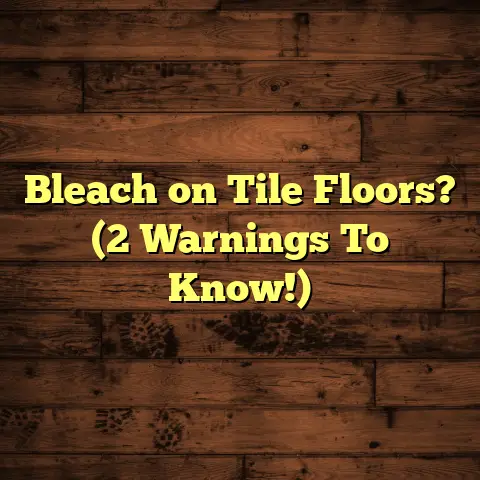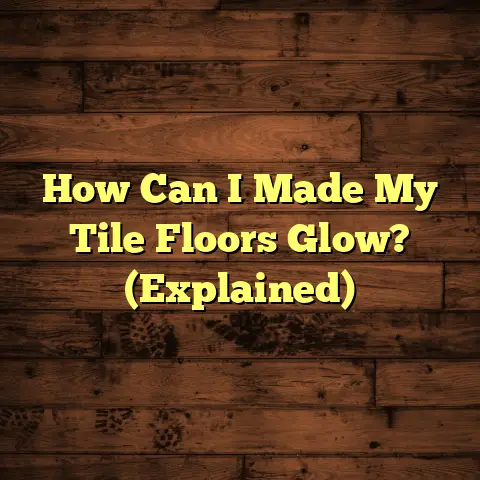Dog Peed on Hardwood? (4 Steps to Save It!)
Isn’t it ironic? We choose hardwood floors for their classic beauty, their durability, and the way they elevate a room. Then, our furry best friend decides that corner is the perfect spot. Suddenly, that pristine surface is under siege!
I’ve seen it countless times as a flooring contractor. The panic, the frustration, the desperate search for a solution. Don’t worry; you’re not alone. And more importantly, your hardwood floor isn’t doomed. Let’s dive into how you can save it!
Section 1: Understanding the Problem
1.1: The Nature of Dog Urine
Dog urine isn’t just water and a bit of ammonia. It’s a complex cocktail of waste products, including urea, uric acid, creatinine, electrolytes, and various enzymes. This concoction is what makes it so damaging to hardwood.
The real culprit is uric acid. It crystallizes and binds tightly to surfaces, making it notoriously difficult to remove with ordinary cleaning. This is why you might clean up a puddle and still be left with a lingering odor or a stain that just won’t budge.
Furthermore, the pH of dog urine can vary, but it’s often acidic. This acidity can etch into the finish of your hardwood floor, dulling its sheen and creating a visible mark.
And of course, there’s the moisture. Hardwood and water are not friends. Prolonged exposure can lead to warping, cupping, and even rot.
According to the American Kennel Club, urinary tract infections (UTIs) can change the composition of a dog’s urine, making it even more potent and potentially damaging.
1.2: Common Reactions and Missteps
The first reaction? Usually a mix of surprise and maybe a little annoyance, right? I get it. But how you react in those first few minutes can make all the difference.
One of the biggest mistakes I see is waiting too long to clean it up. The longer the urine sits, the deeper it penetrates into the wood fibers.
Another common error is using the wrong cleaning products. I’ve seen people reach for bleach, ammonia-based cleaners, or even abrasive scrub brushes. Big no-no! These can strip the finish, discolor the wood, or even cause permanent damage.
Think of it this way: you wouldn’t use sandpaper on your car’s paint job, would you? The same principle applies to your hardwood floor.
I also frequently encounter folks who rub or scrub the area vigorously. This only spreads the urine and grinds it further into the wood. Blotting is key!
Section 2: The Four Steps to Save Your Hardwood Floor
Okay, now for the good stuff. Here’s my four-step plan to tackle that dog pee and rescue your hardwood.
Step 1: Act Quickly
Time is of the essence. The faster you act, the less damage the urine can inflict.
-
Blot, blot, blot: Grab a stack of paper towels or a clean, absorbent cloth. Gently blot the area, pressing down firmly to soak up as much urine as possible. Avoid rubbing or scrubbing. Change the paper towels frequently until they come up mostly dry.
-
Assess the damage: Once you’ve blotted up the excess urine, take a close look at the area. Is there a visible stain? Can you detect an odor? This will help you determine the next steps.
-
Ventilate the area: Open windows or turn on a fan to help dry the area quickly. This will prevent moisture from lingering and potentially causing further damage.
I can’t stress this enough: immediate action is crucial. Every minute counts!
Step 2: Clean the Affected Area
Now that you’ve blotted up the urine, it’s time to clean the area thoroughly.
-
Choose your cleaning solution: You have a few options here:
- Commercial hardwood floor cleaner: Look for a pH-neutral cleaner specifically designed for hardwood floors. Follow the manufacturer’s instructions carefully.
- Enzyme-based cleaner: These cleaners contain enzymes that break down the uric acid in dog urine, neutralizing odors and helping to remove stains. These are my go-to for pet accidents.
- DIY solution: Mix one cup of white vinegar with one gallon of warm water. This is a milder option that can be effective for light cleaning.
-
Apply the cleaner: Lightly dampen a clean cloth or sponge with your chosen cleaning solution. Gently wipe the affected area, working from the outside in to prevent spreading the stain. Avoid saturating the wood.
-
Let it sit: Allow the cleaner to sit on the affected area for a few minutes (refer to the product’s instructions). This will give it time to penetrate the wood and break down the urine.
-
Rinse and dry: Dampen a clean cloth with plain water and wipe the area to remove any remaining cleaner. Dry the area thoroughly with a clean, dry cloth.
-
Repeat if necessary: If the stain or odor persists, repeat the cleaning process.
Important Note: Always test your cleaning solution in an inconspicuous area first to ensure it doesn’t damage the finish of your hardwood floor.
Step 3: Treating Odors and Stains
Sometimes, even after cleaning, odors and stains can linger. Here’s how to tackle them:
-
Enzyme-based cleaners: If you haven’t already used one, now’s the time. Enzyme-based cleaners are specifically designed to break down the uric acid crystals that cause odors and stains. Follow the product’s instructions carefully. You might need to apply it several times for stubborn odors.
-
Baking soda: Baking soda is a natural odor absorber. Sprinkle a generous amount of baking soda over the affected area and let it sit overnight. Vacuum it up the next day.
-
Vinegar: For light stains, try applying a paste of baking soda and vinegar. Let it sit for a few hours, then wipe it away with a damp cloth.
-
Hydrogen peroxide: For darker stains, you can try applying a small amount of 3% hydrogen peroxide. Test it in an inconspicuous area first, as it can lighten the wood. Let it sit for a few hours, then wipe it away with a damp cloth.
-
Sanding and refinishing: If the stain is deep and persistent, you may need to lightly sand the affected area and refinish it. This is best left to a professional, as it requires specialized tools and knowledge.
I’ve seen enzyme cleaners work wonders on even the most stubborn odors. Don’t give up!
Step 4: Prevention for the Future
Prevention is always better than cure. Here are some tips to help prevent future accidents:
-
Potty training: Make sure your dog is properly potty trained. Take them outside frequently, especially after meals and before bedtime. Reward them when they eliminate outside.
-
Regular vet checkups: Urinary tract infections and other medical conditions can cause dogs to have accidents indoors. Regular vet checkups can help identify and treat these problems.
-
Protective coatings: Consider applying a protective coating to your hardwood floor. This can help prevent urine from penetrating the wood and causing damage.
-
Area rugs: Place area rugs in high-traffic areas and in spots where your dog is likely to have accidents. This will protect your hardwood floor from urine and other spills.
-
Flooring alternatives: If you have a dog that frequently has accidents indoors, you might consider installing a more pet-friendly flooring option, such as tile or laminate.
According to the American Veterinary Medical Association (AVMA), proper training and regular vet care are essential for preventing indoor accidents.
Section 3: When to Call the Professionals
Sometimes, despite your best efforts, the damage is too severe to handle on your own. Here are some situations where you should call a professional flooring contractor:
- Severe stains: If the stain is deep and persistent, and doesn’t respond to cleaning, a professional may be able to sand and refinish the affected area.
- Damage to the wood: If the urine has caused the wood to warp, cup, or rot, you’ll need to replace the damaged boards. A professional can do this quickly and efficiently.
- Persistent odors: If the odor lingers despite cleaning efforts, a professional may be able to use specialized equipment and techniques to eliminate it.
When hiring a professional cleaning service, be sure to ask about their experience with pet stains and odors. Get references and read reviews to ensure they’re qualified to handle the job.
I’ve seen professionals work miracles on floors that I thought were beyond saving. Don’t hesitate to call in the experts if you’re feeling overwhelmed.
Section 4: Conclusion
Dog accidents happen. It’s a fact of life for pet owners. But with a swift response and the right techniques, you can save your hardwood floor from permanent damage.
Remember, act quickly, clean thoroughly, treat odors and stains, and take steps to prevent future accidents.
And if all else fails, don’t be afraid to call in the professionals.
With a little knowledge and effort, you can keep your hardwood floor looking beautiful for years to come, even with a furry friend in the house. You’ve got this!





